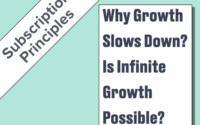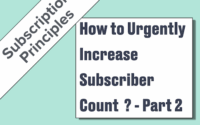Communicating with Subscribers: Service vs. Marketing Messages
In recent years, regulators clarified communication rules through GDPR and the California Consumer Privacy Act. Let’s review the rules, the different types of messages, and what can be done.
1. Rule #1: the consent
The rule is simple: you can only communicate with a prospect, customer or subscriber if you captured their consent to receive communications.
“Consent to receive communications” means :
Explicitly capturing the prospect’s, customer’s, or subscriber’s agreement to receive messages. In action term, it means customer must check a box next to a text like “yes, I agree to receive messages”.
There’s no such thing as a “global” consent. You cannot require customers to accept both Terms & Conditions AND consent to receive messages at the same time.
2. Exceptions to the rule of consent
In some specific cases, it’s possible to send messages to customers without their consent. These are messages necessary for the correct execution of the contract between the customer and the merchant.
These include transaction-related messages:
- about the order: i.e. order confirmation, shipping confirmation
Second, these are administrative messages:
- about the account management: i.e. account creation, account activation
- about security: i.e. password change, 2-factor authentication
Finally, for subscriptions, these are messages relating to the subscription lifecycle:
- about the imminence of renewal
- about the confirmation of automatic renewal and the new expiration date
- about payment methods: i.e., payment methods needing an update
These can be called Service Messages or Transactional Messages. The merchant can send them to any customer even opt-out customers.
When a subscription is terminated, the relationship between the merchant and the subscriber stops. It’s no longer possible to send a Service Message after the subscription has expired because there’s no service anymore.
3. The other type of messages and the mixed ones
Messages that aren’t Service Messages are Marketing Messages. They require the customer’s consent because they expose them to commercial offers.
If we insert a commercial offer in a Service Message, then the message becomes a Marketing Message. Therefore, it requires explicit consent.
Mixing genres is not a good idea:
First, in the event of a disagreement between the customer and merchant, the regulator will rule in favor of the customer. The merchant may risk a fine. Second, the marketing message is diluted and therefore not very effective. The risk-benefit ratio is not good.
For example: I order a subscription and I immediately receive an email with the subject line “Order Confirmation”. I expect this message, it’s unlikely I’ll open and read it entirely. I won’t see the marketing offer included in it.
4. The gray zone
The gray zone exists between Service and Marketing messages, requiring caution and finesse. Here are a couple of example to give the mindset.
First, it’s possible to subtlety push marketing offers without including them directly in the messages but by displaying them along the customer’s journey.
For example, your bank, probably does it under the cover of security. You receive an email informing you that a message is waiting for you in your bank’s website. By connecting to it, you will be exposed to multiple commercial offers.
Secondly, we want to get customer’s consent. To this purpose, we send a “keep in touch” email to former customers proposing to subscribe to a newsletter. Such a message is not solicited but may look acceptable by regulators if it is sent with a low frequency and without including any commercial offer in it.
Finally, still in the gray area are all messages inviting customers to make the best use of their subscription. It’s interesting for customers as they use more features and get more for the same price. And it’s also interesting for the merchant as retention rate will increase (see the article on usage). It’s a win-win.
👉 Key takeaways 👈
- Service messages can be sent to any customers even “marketing opt-out” ones.
- After the subscription expires, Service messages must stop. Only Marketing messages should be sent.
- Not respecting customer’s consent is a very bad idea. However, it’s possible to be subtle and manage to display commercial offers without breaking the law.



